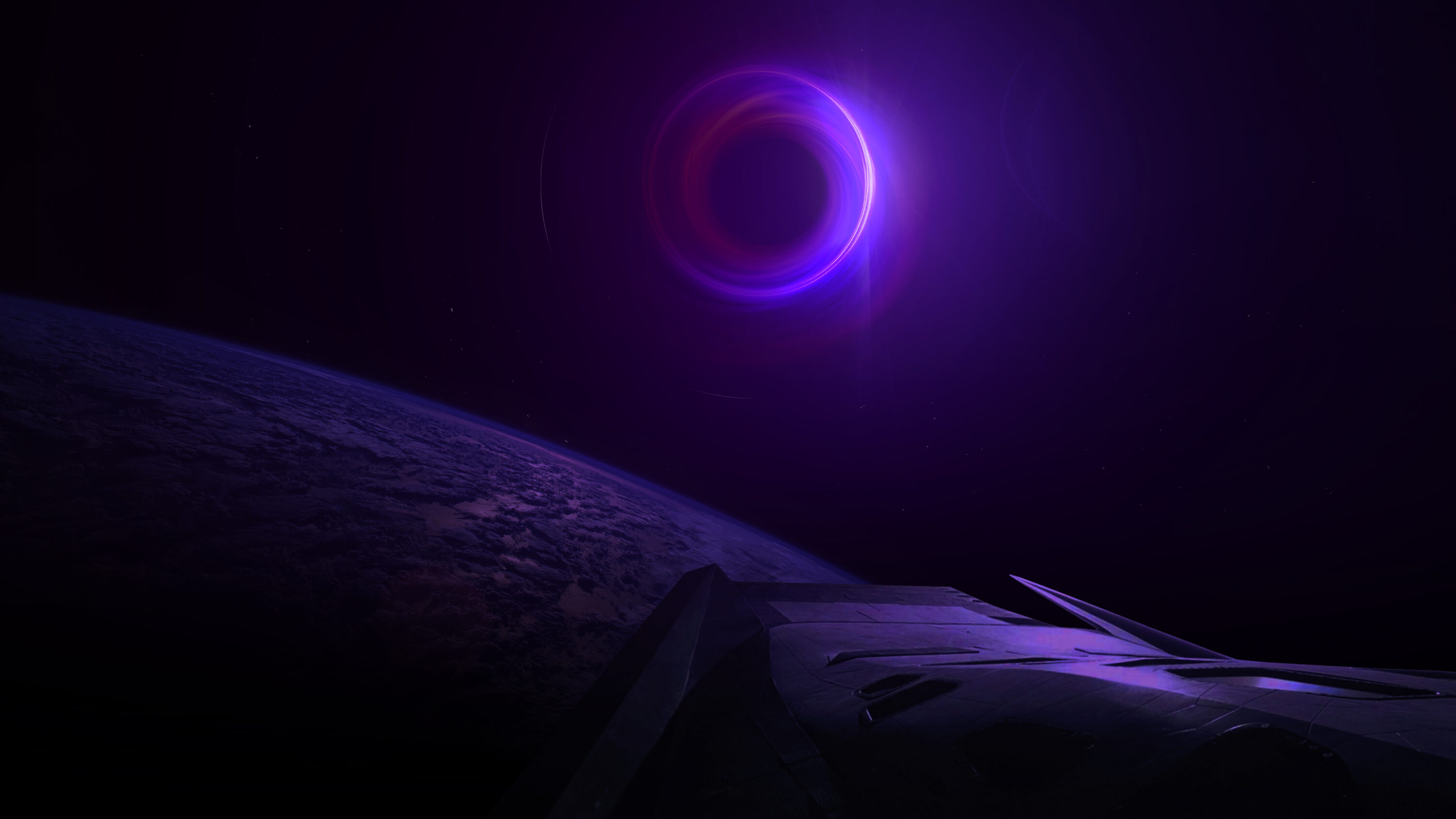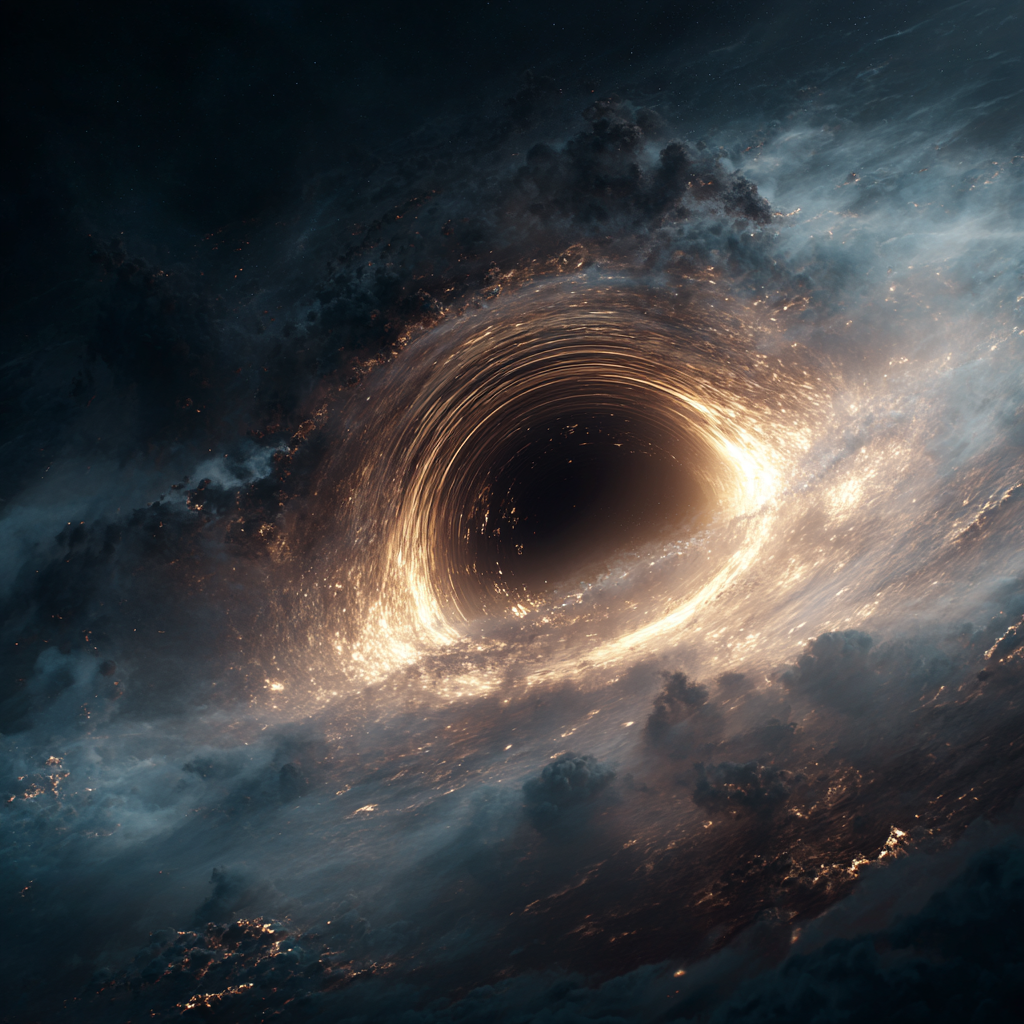
Accretion disks are one of the most fascinating and ubiquitous structures in astrophysics – swirling disks of gas, dust, and plasma that form around massive central objects like black holes, neutron stars, white dwarfs, or even baby stars.
How do Accretion Disks form?
Accretion disks form when a massive central object pulls in orbiting material that possesses too much angular momentum to fall directly into it, creating a flat, spinning disk. This matter spirals inward due to viscosity and turbulence, losing energy and angular momentum as it spirals, leading to intense heating and the emission of radiation. The process is driven by gravity and the conservation of angular momentum, transforming the gas and dust into highly energetic phenomena like X-rays and powering active galactic nuclei, Quasars, even near light speed jets. The center of the accretion disc can be so dense that time dilation becomes absolute, and the entire history of the light traveling around the black hole is visible in the photon ring. This is called the holographic effect.
Elliot’s Accretion Disk Calculator
Here is a little tool I wrote with Claude to understand the viscosity of an accretion disk, whether it is a black hole, or neutron star, or even a protoplanetary disc, the physics are very similar. The mass of the central object is key, as is the magnetic field surround it.
Make sure you adjust the settings, as you explore this cool Accretion Disk Calculator that I made with Claude OPUS 4.1. Start with the lowest time/speed setting and try to find equilibrium states for the various objects. Feel free to use the code in your own projects, I made it a download below the calculator
Accretion Disk Physics
The Function of Accretion Disks in the Cosmos
Accretion disks are a ubiquitous phenomenon in astrophysics; active galactic nuclei, protoplanetary disks, and gamma ray bursts all involve accretion disks. These disks very often give rise to astrophysical jets coming from the vicinity of the central object. Jets are an efficient way for the star-disk system to shed angular momentum without losing too much mass.
The most prominent accretion disks are those of active galactic nuclei and of quasars, which are the supermassive black holes at the center of galaxies. As matter enters the accretion disc, it follows a trajectory called a tendex line, which describes an inward spiral. This is because particles rub and bounce against each other in a turbulent flow, causing frictional heating which radiates energy away, reducing the particles’ angular momentum, allowing the particle to drift inward, driving the inward spiral. The loss of angular momentum manifests as a reduction in velocity; at a slower velocity, the particle must adopt a lower orbit. This is why, over time, black holes dissipate and evaporate.
The large luminosity of quasars is believed to be a result of gas being accreted by supermassive black holes.[3] Elliptical accretion disks formed at tidal disruption of stars can be typical in galactic nuclei and quasars.[4] The accretion process can convert about 10 percent to over 40 percent of the mass of an object into energy as compared to around 0.7 percent for nuclear fusion processes.[5] In close binary systems the more massive primary component evolves faster and has already become a white dwarf, a neutron star, or a black hole, when the less massive companion reaches the giant state and exceeds its Roche lobe. A gas flow then develops from the companion star to the primary. Angular momentum conservation prevents a straight flow from one star to the other and an accretion disk forms instead.
Accretion disks thats surround T Tauri stars or Herbig stars are called protoplanetary disks because they are thought to be the progenitors of planetary systems. The accreted gas in this case comes from the molecular cloud out of which the star has formed rather than a companion star.
The Physics of an Accretion Disk
In the 1940s, models were first derived from basic physical principles.[6] In order to agree with observations, those models had to invoke a yet unknown mechanism for angular momentum redistribution. If matter is to fall inward it must lose not only gravitational energy but also lose angular momentum. Since the total angular momentum of the disk is conserved, the angular momentum loss of the mass falling into the center has to be compensated by an angular momentum gain of the mass far from the center. In other words, angular momentum should be transported outward for matter to accrete. According to the Rayleigh stability criterion, ∂ ( R 2 Ω ) ∂ R > 0 ,
where Ω 

Sub Eddington Accretion Disks
When the accretion rate is sub-Eddington and the opacity very high, the standard thin accretion disk is formed. It is geometrically thin in the vertical direction (has a disk-like shape), and is made of a relatively cold gas, with a negligible radiation pressure. The gas goes down on very tight spirals, resembling almost circular, almost free (Keplerian) orbits. Thin disks are relatively luminous and they have thermal electromagnetic spectra, i.e. not much different from that of a sum of black bodies. Radiative cooling is very efficient in thin disks. The classic 1974 work by Shakura and Sunyaev on thin accretion disks is one of the most often quoted papers in modern astrophysics. Thin disks were independently worked out by Lynden-Bell, Pringle, and Rees. Pringle contributed in the past thirty years many key results to accretion disk theory, and wrote the classic 1981 review that for many years was the main source of information about accretion disks, and is still very useful today.
Super-Eddington accretion disks (slim disks, Polish doughnuts)
Unsolved problem in physics
Accretion disk QPOs: Quasi-periodic oscillations happen in many accretion disks, with their periods appearing to scale as the inverse of the mass of the central object. Why do these oscillations exist? Why are there sometimes overtones, and why do these appear at different frequency ratios in different objects?
More unsolved problems in physics
The theory of highly super-Eddington black hole accretion, M≫MEdd, was developed in the 1980s by Abramowicz, Jaroszynski, Paczyński, Sikora, and others in terms of “Polish doughnuts” (the name was coined by Rees). Polish doughnuts are low viscosity, optically thick, radiation pressure supported accretion disks cooled by advection. They are radiatively very inefficient. Polish doughnuts resemble in shape a fat torus (a doughnut) with two narrow funnels along the rotation axis. The funnels collimate the radiation into beams with highly super-Eddington luminosities.
Slim disks (name coined by Kolakowska) have only moderate super-Eddington accretion rates, M≥MEdd, rather disk-like shapes, and almost thermal spectra. They are cooled by advection, and are radiatively ineffective. They were introduced by Abramowicz, Lasota, Czerny, and Szuszkiewicz in 1988.
Accretion Disk Math and Examples
Black Hole Physics: Energy, Orbits, and Accretion Efficiency
Accretion disks around black holes are governed by the general relativistic equations of motion for test particles in a curved spacetime. The efficiency of an accretion disk depends on how much gravitational potential energy is converted into radiation as matter spirals inward.
Orbital Dynamics and ISCO
In the Schwarzschild metric, the specific energy E and angular momentum L per unit mass of a particle in a circular orbit of radius r are approximately:
E = (1 − 2GM/rc²) ÷ √(1 − 3GM/rc²)
L = √(GMr) ÷ √(1 − 3GM/rc²)
The innermost stable circular orbit (ISCO) for a non-rotating black hole occurs at:
r₍ISCO₎ = 6GM/c²
Inside this radius, no stable circular orbits exist — matter plunges into the event horizon.
For a rotating (Kerr) black hole with spin parameter a*, the ISCO is closer to the black hole (for prograde orbits):
r₍ISCO₎ = r_g [ 3 + Z₂ − √((3 − Z₁)(3 + Z₁ + 2Z₂)) ]
where r_g = GM/c²,
Z₁ = 1 + (1 − a*²)^(1/3)[(1+a*)^(1/3) + (1−a*)^(1/3)],
Z₂ = √(3a*² + Z₁²).
The radiative efficiency is:
η = 1 − E₍ISCO₎
For a Schwarzschild black hole, η ≈ 0.057 (5.7%), while for a maximally rotating Kerr black hole, η ≈ 0.42 (42%) — far higher than nuclear fusion (≈0.7%).
Energy Dissipation and Luminosity
Disk luminosity scales with accretion rate:
L ≈ η × Ṁ × c²
The Eddington luminosity is the maximum steady luminosity before radiation pressure halts further accretion:
L₍Edd₎ = (4πGMmₚc)/σₜ
where mₚ is the proton mass and σₜ is the Thomson scattering cross-section.
Photon Rings and Light Bending
Photons traveling near r ≈ 1.5 rₛ (where rₛ = 2GM/c²) can orbit several times before escaping, forming photon rings that encode the black hole’s mass M and spin a*.
Computing Sagittarius A
Setup (constants/assumptions)
- Black-hole mass M ≈ 4.30 × 10⁶ M☉
- Distance D ≈ 8.2 kpc (for angular sizes)
- c = 2.99792458×10⁸ m/s, G = 6.67430×10⁻¹¹ m³·kg⁻¹·s⁻²
- mₚ = 1.6726×10⁻²⁷ kg, σₜ = 6.6525×10⁻²⁹ m²
Characteristic radii (exact GR definitions; values shown numerically)
- Gravitational radius: r_g = GM/c² ≈ 6.35×10⁹ m ≈ 6.35×10⁶ km ≈ 0.04245 AU
- Schwarzschild radius: r_s = 2r_g ≈ 1.27×10¹⁰ m ≈ 0.08489 AU
ISCO radius (prograde)
- Schwarzschild (a* = 0): r_ISCO = 6 r_g ≈ 3.81×10¹⁰ m ≈ 0.2547 AU
- Kerr (a* = 0.5): r_ISCO ≈ 4.233 r_g ≈ 2.69×10¹⁰ m ≈ 0.1796 AU
- Kerr (a* = 0.9): r_ISCO ≈ 2.321 r_g ≈ 1.47×10¹⁰ m ≈ 0.0985 AU
Orbital period at ISCO (Keplerian estimate; GR will reduce these slightly)
- a* = 0: T_ISCO ≈ 32.6 min
- a* = 0.5: T_ISCO ≈ 19.3 min
- a* = 0.9: T_ISCO ≈ 7.84 min
(Useful for discussing observed sub-hour variability.)
Radiative efficiency and luminosity
- Efficiency η = 1 − E_ISCO (typical benchmarks):
- a* = 0: η ≈ 0.057
- a* = 0.5: η ≈ 0.082
- a* = 0.9: η ≈ 0.155
- Eddington luminosity: L_Edd = (4πGMmₚc)/σₜ ≈ 5.41×10³⁷ W ≈ 5.41×10⁴⁴ erg/s
- Accretion rate for L = L_Edd:Ṁ_Edd ≈ L_Edd / (η c²)
- For η = 0.057 (Schwarzschild): Ṁ_Edd ≈ 0.167 M☉/yr
- For η = 0.1 (rule-of-thumb): Ṁ_Edd ≈ 0.095 M☉/yr
Sgr A* is extremely under-luminous: observed bolometric luminosity is ~10³⁶–10³⁷ erg/s (i.e., ~10⁻⁹ to 10⁻⁸ of L_Edd), implying a radiatively inefficient, strongly sub-Eddington flow (advection/outflows dominate).
Angular scales
EHT ring diameter is ~50 μas (≈ 10 r_g across), consistent with strong lensing near the photon orbit.
θ(r_g) ≈ 5.18 μas, θ(r_s) ≈ 10.35 μas
References and Further Reading
- Shakura, N. I., & Sunyaev, R. A. (1973). Black Holes in Binary Systems: Observational Appearance. Astronomy & Astrophysics, 24, 337–355. [Seminal paper introducing the “thin disk” model.]
- Pringle, J. E. (1981). Accretion Disks in Astrophysics. Annual Review of Astronomy and Astrophysics, 19, 137–162. [Classic review article on accretion disk theory.]
- Abramowicz, M. A., Jaroszynski, M., & Sikora, M. (1978). Relativistic, accreting disks. Astronomy & Astrophysics, 63, 221–224. [Origin of the “Polish doughnut” model.]
- Frank, J., King, A., & Raine, D. (2002). Accretion Power in Astrophysics (3rd ed.). Cambridge University Press. [The standard graduate textbook for accretion disk physics.]
- Blandford, R. D., & Znajek, R. L. (1977). Electromagnetic extraction of energy from Kerr black holes. Monthly Notices of the Royal Astronomical Society, 179, 433–456. [Foundation of jet-launching theory.]
- Bardeen, J. M., Press, W. H., & Teukolsky, S. A. (1972). Rotating Black Holes: Locally Nonrotating Frames, Energy Extraction, and Scalar Synchrotron Radiation. The Astrophysical Journal, 178, 347–370. [Defines ISCO and Kerr orbital properties.]
- Thorne, K. S. (1974). Disk-Accretion onto a Black Hole. II. Evolution of the Hole. The Astrophysical Journal, 191, 507–520. [Efficiency limits for Kerr accretion.]
- Event Horizon Telescope Collaboration (2019). First M87 Event Horizon Telescope Results. I-VI. The Astrophysical Journal Letters, 875. [Direct imaging of a black hole’s photon ring.]
- Gravity Collaboration (2020). Detection of orbital motions near the last stable circular orbit of the massive black hole Sgr A*. Astronomy & Astrophysics, 636, L5. [Observed orbital periods near ISCO for Sgr A*.]
- Narayan, R., & Yi, I. (1994). Advection-dominated accretion: A self-similar solution. The Astrophysical Journal, 428, L13–L16. [Key paper on radiatively inefficient flows.]
- Yuan, F., & Narayan, R. (2014). Hot Accretion Flows Around Black Holes. Annual Review of Astronomy and Astrophysics, 52, 529–588. [Review of ADAF and RIAF solutions relevant to Sgr A*.]
- NASA’s Imagine the Universe: Accretion Disks Overview [Excellent public-friendly resource.]
- NASA/GSFC HEASARC: Black Hole Encyclopedia
- ESO – European Southern Observatory: Gravity Instrument & Sgr A* Results
- arXiv.org: Astrophysics > High Energy Astrophysical Phenomena (astro-ph.HE) [Preprints on current black hole and accretion disk research.]

